2017 Science Highlights
A Radio Counterpart to a Neutron Star Merger
On 17 August 2017, the Advanced Laser Interferometer Gravitational Wave Observatory (Advanced LIGO) detected a gravitational wave signal, GW170817, which was rapidly identified to be associated with the inspiral and coalescence of two neutron stars. A burst of gamma-rays, GRB170817A, was detected ~2 seconds after the gravitational wave detection by the Gamma-ray Burst Monitor (GBM) of the Fermi Gamma-ray Space Telescope. With the addition of data from the Advanced Virgo interferometer, the gravitational waves source was localized to an area of 28 deg2 (90% confidence region) and a distance of 40 ± 8 Mpc. There were 49 cataloged galaxies within this volume, allowing astronomers to rapidly search for electromagnetic counterparts. An optical counterpart, designated SSS17a, was detected within ~11 hours of the event by astronomers using the Swope telescope, localizing the merger to the S0-type galaxy NGC 4993 at a distance of 40 Mpc and soon independently confirmed. Following the optical detections, targeted observing campaigns were initiated across the electromagnetic spectrum. Subsequent optical and infrared spectroscopic observations firmly established this optical counterpart to be associated with the neutron star merger GW170817.
In this work, Hallinan et al. report a coordinated effort to use the Jansky VLA, the VLA Low Band Ionosphere and Transient Experiment (VLITE), the Australia Telescope Compact Array (ATCA) and the Giant Metrewave Radio Telescope (GMRT) to constrain the early time radio properties of the neutron star merger. Companion papers report the ultraviolet and X-ray properties and interpret the panchromatic behavior of the transient. The multi-wavelength counterpart to GW170817 is designated EM170817.
Hallinan et al. discovered the radio afterglow of the neutron star merger using the Jansky VLA 16 days after the gravitational wave burst. This radio detection was made possible by the ultra-sensitivity of the Jansky VLA. The radio afterglow is the key element in interpreting the event as a likely relativistic jet driven by the neutron star merger. Continuing observations with the VLBA and the Jansky VLA will solidify the interpretation of this event, heralding a new field of astronomy.
Image: [Left] Radio image created using VLA observations (6 GHz) on 9 September 2017, with the radio counterpart to EM170817 highlighted. Its flux density is 23 ± 3.4 μJy. [Right] A combined image from four VLA observations at 6 GHz spanning 22.6 August–1 September 2017. The flux density at the position of EM170817 is 7.8 ± 2.6 μJy, consistent with a marginal or non-detection.
Publication: G. Hallinan (California Institute of Technology) et al., A Radio Counterpart to a Neutron Star Merger, 16 October 2017, Science, 358, 1579.
Protoplanetary Disks in the ALMA Era
The σ Orionis cluster is important for studying protoplanetary disk evolution, as its intermediate age (~3–5 Myr) is comparable to the median disk lifetime. Ansdell et al. used ALMA to conduct a high-sensitivity survey of dust and gas in 92 protoplanetary disks around σ Orionis members with M* ≳ 0.1 M⊙. These ALMA observations cover the 1.33 mm continuum and several CO J = 2–1 lines: of 92 sources, 37 are detected in the millimeter continuum, 6 in 12CO, 3 in 13CO, and none in C18O. Using the continuum emission to estimate dust mass, the authors find only 11 disks with Mdust ≳ 10 M⊕, indicating that after only a few million years of evolution most disks lack sufficient dust to form giant planet cores. Stacking the individually undetected continuum sources limits their average dust mass to 5X lower than that of the faintest detected disk, supporting theoretical models that indicate rapid dissipation once disk clearing begins. Comparing the protoplanetary disk population in σ Orionis to those of other star-forming regions supports the steady decline in average dust mass and the steepening of the Mdust – M* relation with age; studying these evolutionary trends can inform the relative importance of different disk processes during key planet formation eras. External photoevaporation from the central O9 star is influencing disk evolution throughout the region: dust masses clearly decline with decreasing separation from the photoionizing source. Collectively, the findings of Ansdell et al. indicate that giant planet formation is inherently rare and/or well underway by a few million years of age.
Illustration caption: Continuum images at 1.33 mm of the 37 detected disks in the σ Orionis ALMA sample, ordered by decreasing flux density. Images are 2 x 2 arcsec; the typical beam size of 0.31 × 0.25 arcsec is shown in the first panel (top row, left end).
Publication: M. Ansdell (University of Hawai‘i at Mānoa) et al., An ALMA Survey of Protoplanetary Disks in the σ Orionis Cluster, 2017, Astronomical Journal, 153, 240.
Mapping a Complete Debris Disk
MacGregor et al. present ALMA mosaic observations at 1.3 mm (223 GHz) of the Fomalhaut system. These observations provide the first millimeter map of the continuum dust emission from the complete outer debris disk with uniform sensitivity, enabling the first conclusive detection of apocenter glow. The authors adopt a modeling approach that accounts for the eccentric orbital parameters of a collection of particles within the disk. The outer belt is radially confined with an inner edge of 136.3 ± 0.9 Astronomical Units (AU) and width of 13.5 ± 1.8 AU, with a best-fit eccentricity of 0.12 ± 0.01.
Assuming a size distribution power-law index of q = 3.46 ± 0.09, the dust absorptivity power-law index β is constrained to be 0.9 < β < 1.5. The geometry of the disk is robustly constrained with inclination 65.6° ± 0.3°, position angle 337.9° ± 0.3°, and argument of periastron 22.5° ± 4.3°. These ALMA observations do not confirm any of the azimuthal features found in previous imaging studies of the disk with HST, the Submillimeter Common-User Bolometer Array, and ALMA. However, they cannot rule out structures ≤10 AU in size or that only affect smaller grains. The central star is clearly detected with a flux density of 0.75 ± 0.02 mJy, significantly lower than predicted by current photospheric models.
Image: ALMA image of the 1.3 mm continuum emission from Fomalhaut. The dashed white ellipse in the lower left corner shows the natural weight beam size of 1.56 x 1.15 arcsec.
Publications: Meredith A. MacGregor (Harvard-Smithsonian Center for Astrophysics) et al., A Complete Map of the Fomalhaut Debris Disk, 2017, Astrophysical Journal, 842, 8.
Exocometary Gas
Recent ALMA observations present mounting evidence for the presence of exocometary gas released within Kuiper Belt analogs around nearby main-sequence stars. This represents a unique opportunity to study their ice reservoir at the younger ages when volatile delivery to planets is most likely to occur. Matrà et al. present the detection of CO J = 2-1 emission colocated with dust emission from the cometary belt in the 440 Myr old Fomalhaut system. Through spectrospatial filtering, they achieve a 5.4σ detection and determine that the ring's sky-projected rotation axis matches that of the star.
The derived CO mass (0.65-42 x 10-7 M⊕,) is the lowest of any circumstellar disk detected to date and must be of exocometary origin. Using a steady-state model, the authors estimate the CO + CO2 mass fraction of exocomets around Fomalhaut to be between 4.6% and 76%, consistent with Solar System comets and the two other belts known to host exocometary gas. This is the first indication of a similarity in cometary compositions across planetary systems that may be linked to their formation scenario and is consistent with direct interstellar medium inheritance. In addition, the authors find tentative evidence that 49 ± 27% of the detected flux originates from a region near the eccentric belt's pericenter. If confirmed, the latter may be explained through a recent impact event or CO pericenter glow due to exocometary release within a steady-state collisional cascade. In the latter scenario, Matrà et al. show how the azimuthal dependence of the CO release rate leads to asymmetries in gas observations of eccentric exocometary belts.
Image: Model image for the maximum CO J = 2-1 flux enhancement expected at pericenter with respect to apocenter through steady-state CO production in the Fomalhaut ring. The model predicts a flux density enhancement of ~14.5% at the pericenter with respect to the apocenter location.
Publication: L. Matrà (University of Cambridge) et al., Detection of Exocometary CO within the 440 Myr-old Fomalhaut Belt, 2017, Astrophysical Journal, 842, 9.
A Fast Radio Burst and its Host
Fast Radio Bursts (FRBs) are astronomical radio flashes of an unknown physical nature with durations of milliseconds. Their dispersive arrival times suggest an extragalactic origin and imply radio luminosities orders of magnitude larger than those of all known short-duration radio transients. To date, all FRBs have been detected with large single-dish telescopes with arcminute localizations, and attempts to identify their source or host galaxy have relied on the contemporaneous variability of field sources or the presence of peculiar field stars or galaxies. These attempts have not resulted in an unambiguous association with a host or multi-wavelength counterpart.
In this contribution, Chatterjee et al. report the sub-arcsecond localization of FRB 121102, the only known repeating burst source, using high-time-resolution VLA radio that directly image the bursts. This precise localization revealed that FRB 121102 originates within 100 milli-arcseconds of a faint 180 micro-Jansky persistent radio source with a continuum spectrum consistent with non-thermal emission, and a faint optical counterpart. The flux density of the persistent radio source varies by ~10% on day timescales, and very long baseline radio interferometry yields an angular size of < 1.7 milli-arcseconds. These observations are inconsistent with the FRB having a Galactic origin or its source being located within a prominent star-forming galaxy. Instead, the source appears to be co-located with a low-luminosity active galactic nucleus or a previously unknown type of extragalactic source. Localization and identification of a host or counterpart has been essential to understanding the origins and physics of other kinds of transient events, including gamma-ray bursts and tidal disruption events. However, if other FRBs have similarly faint radio and optical counterparts, this research implies that direct sub-arcsecond localizations may be the only path to reliable associations.
Image: VLA image (3 GHz) of the FRB field at 2 arcsec resolution. The overlapping white circles are the Arecibo Observatory detection uncertainty regions (3′ beam FWHM). The radio counterpart of the bursts detected by the VLA is highlighted in a 20 arcsec white square within the overlap. [Inset] Gemini Observatory image of the 20 arcsec square showing an optical counterpart (rAB = 25.1 ± 0.1 mag), as identified by the 5 arcsec bars.
Publication: Shami Chatterjee (Cornell University) et al., A Direct Localization of a Fast Radio Burst and its Host, 2017, Nature, 541, 58.
Membrane Molecules on Titan
Recent simulations have indicated that vinyl cyanide is the best candidate molecule for the formation of cell membranes/vesicle structures in the hydrocarbon-rich lakes and seas of Titan, Saturn’s moon. Titan is as large Mars, with a hazy atmosphere comprised primarily of nitrogen and a smattering of organic molecules that is possibly similar to Earth’s primordial atmosphere. Although the existence of vinyl cyanide (C2H3CN) on Titan was previously inferred using mass spectrometry from the Cassini spacecraft, a definitive detection has been lacking.
Palmer et al. report the first spectroscopic detection of vinyl cyanide in Titan’s atmosphere, obtained using archival ALMA collected February – May 2014. The authors detected the three strongest rotational lines of C2H3CN in the 230 - 232 GHz frequency range, each with better than 4σ confidence. Radiative transfer modeling suggests that most of the C2H3CN emission originates at altitudes of ≳200 km, in agreement with recent photochemical models. The vertical column densities implied by the best-fit models are in the range of 3.7 × 1013 to 1.4 × 1014 cm−2. The corresponding production rate of vinyl cyanide and its saturation mole fraction imply the availability of sufficient dissolved material to form ~107 cell membranes/cm3 in Titan’s sea, Ligeia Mare.
Image Caption: Archival ALMA data have confirmed that molecules of vinyl cyanide reside in the atmosphere of Titan, Saturn's largest moon. Titan is shown in an optical (atmosphere) infrared (surface) composite from NASA's Cassini spacecraft. In a liquid methane environment, vinyl cyanide may form membranes. Credit: B. Saxton (NRAO/AUI/NSF); NASA.
Publication: Maureen Y. Palmer (NASA-Goddard, St. Olaf College, Catholica University of America) et al., ALMA Detection and Astrobiological Potential of Vinyl Cyanide on Titan, 5 July 2017, Science Advances, Vol. 3, no. 7.
Probing Molecules in Supernova Remnants
Most massive stars end their lives in core-collapse supernova (SN) explosions and enrich the interstellar medium with explosively nucleosynthesized elements. Following core collapse, the explosion is subject to instabilities as the shock propagates outward through the progenitor star. Observations of the composition and structure of the innermost regions of a core-collapse supernova provide a direct probe of the instabilities and nucleosynthetic products. SN 1987A in the Large Magellanic Cloud is one of very few supernovae for which the inner ejecta can be spatially resolved but are not yet strongly affected by interaction with the surroundings.
F.J. Abellán (Universidad de Valencia) and his colleagues analyze ALMA observations of SN 1987A acquired that are the highest resolution to date and that reveal the detailed morphology of cold molecular gas in the innermost regions of the remnant. The 3D distributions of carbon and silicon monoxide (CO and SiO) emission differ, but both have a central deficit, or torus-like distribution, possibly a result of radioactive heating during the first weeks. The size scales of the clumpy distribution are compared quantitatively to models, demonstrating how progenitor and explosion physics can be constrained.
M. Matsuura (Cardiff University, University College London) et al. report the first molecular line survey of SN87A at millimeter wavelengths. ALMA detected cold (20–170 K) CO, 28SiO, HCO+ and SO, with weaker lines of 29SiO from ejecta, the first identification of HCO+and SO in a young supernova remnant. A dip in the J = 6–5 and 5–4 SiO line profiles suggests that the ejecta morphology is elongated. The CO and SiO line profile differences are consistent with hydrodynamic simulations, which show that Rayleigh–Taylor instabilities cause mixing of gas, with heavier elements much more disturbed, making more elongated structure. Low 29Si and 30Si abundances are consistent with nucleosynthesis models that show inefficient formation of neutron-rich isotopes in a low-metallicity environment, such as the Large Magellanic Cloud. The deduced large mass of HCO+ (∼5 × 10−6 M⊙) and small SiS mass (<6 × 10−5 M⊙) might be explained by some mixing of elements immediately after the explosion. The mixing might have caused some hydrogen from the envelope to sink into carbon- and oxygen-rich zones after the explosion, enabling the formation of a substantial mass of HCO+. Oxygen atoms may have penetrated into silicon and sulphur zones, suppressing formation of SiS.
Image: Remnant of Supernova 1987A as seen by ALMA. Purple area indicates emission from SiO molecules. Yellow area is emission from CO molecules. The blue ring is Hubble data that has been artificially expanded into 3-D. Credit: ALMA (ESO/NAOJ/NRAO); R. Indebetouw; NASA/ESA Hubble.
Publications: F.J. Abellán (Universidad de Valencia) et al. Very Deep inside the SN 1987A Core Ejecta: Molecular Structures Seen in 3D, 2017, Astrophysical Journal Letters, 842, L24.
M. Matsuura (Cardiff University, University College London) et al., ALMA spectral survey of Supernova 1987A – molecular inventory, chemistry, dynamics and explosive nucleosynthesis, 2017, Monthly Notices of the Royal Astronomical Society, 469, 3347.
The Most Distant Galaxy
Laporte et al. report on the detailed analysis of a gravitationally lensed Y-band dropout – designated A2744_YD4 – selected from deep Hubble Space Telescope (HST) imaging in the Frontier Field cluster Abell 2744. Band 7 observations with ALMA indicate the proximate detection of a significant 1 mm continuum flux suggesting the presence of dust for a star-forming galaxy with a photometric redshift of z = 8.38. Deep X-SHOOTER spectra confirms the high-redshift identity of A2744_YD4 via the detection of Lyα emission at a redshift z = 8.38. The association with the ALMA detection is confirmed by the presence of [O III] 88 μm emission at the same redshift. Although both emission features are only significant at the 4σ level, the authors argue their joint detection and the positional coincidence with a high-redshift dropout in the HST images confirms the physical association. Analysis of the available photometric data and the modest gravitational magnification (μ ~ 2) indicates A2744_YD4 has a stellar mass of ∼2 × 109 M⊙, a star formation rate of ∼20 M⊙ per year and a dust mass of ∼6 × 106 M⊙. These observations imply that the interstellar medium in galaxies can be substantially enriched with metals and dust when the Universe was only ~ 600 million years old.
Image: ALMA image contours superposed on a HST visible (F160W) image.
Publication: N. Laporte (University College London, Pontificia Universidad Católica de Chile, Millennium Institute of Astrophysics) et al., Dust in the Reionization Era: ALMA Observations of a z = 8.38 Gravitationally Lensed Galaxy, 2017, Astrophysical Journal Letters, 837, L21.
Large-scale Magnetic Fields in a Distant Galaxy
Magnetic fields play a pivotal role in the physics of interstellar medium in galaxies, but there are few observational constraints on how they evolve across cosmic time. Spatially resolved synchrotron polarization maps at radio wavelengths reveal well-ordered, large-scale magnetic fields in nearby galaxies that are believed to grow from a seed field via a dynamo effect. To directly test and characterize this theory requires magnetic field strength and geometry measurements in cosmologically distant galaxies, which are challenging to obtain due to the limited sensitivity and angular resolution of radio telescopes.
In this work, Mao and her colleagues report the cleanest measurements yet of magnetic fields in a galaxy beyond the local volume, free of the systematics traditional techniques encounter. Using the Jansky VLA and exploiting the scenario where the polarized radio emission from a background source is gravitationally lensed by a foreground galaxy at z = 0.439, using broadband radio polarization data, the authors detected coherent micro-Gauss magnetic fields in the lensing disk galaxy as seen 4.6 Gyr ago, with similar strength and geometry to local volume galaxies. This is the highest redshift galaxy whose observed coherent magnetic field property is compatible with a mean-field dynamo origin.
Image: The 5 GHz total intensity radio contours from the Jansky VLA superposed on a Hubble Space Telescope visible (F814W) image of the gravitational lensing system CLASS B1152+199.
Publication: S. A. Mao (Max Planck Institute for Radio Astronomy) et al., Detection of Microgauss Coherent Magnetic Fields in a Galaxy Five Billion Years Ago, 2017, Nature Astronomy, 1, 621 (28 August 2017)
Young, Low Mass Stars Orbiting the Galactic Center
Low mass star formation was thought to be inhibited with a few parsecs of the Galactic Center by the turbulent, dense environment. Yusef-Zadeh et al., however, report the discovery of 11 bipolar outflows within a projected distance of 1 parsec of the Galactic Center, Sgr A*, based on deep ALMA observations of 13CO, H30α, and SiO (5-4) lines with sub-arcsecond spatial resolution and ~1.3 km/sec velocity resolution.
These unambiguous signatures of young protostars manifest as approaching and receding lobes of dense gas swept up by the jets created during the formation and early evolution of stars. The lobe masses and momentum transfer rates are consistent with young protostellar outflows found throughout the disk of the Galaxy. The mean dynamical age of the outflow population is estimated to be 6.5 x 103 years. The rate of star formation is ~5 × 10−4 M⊙per year, assuming a mean stellar mass of ~0.3 M⊙. This discovery provides evidence that star formation is taking place within clouds surprisingly close to Sgr A*, perhaps due to events that compress the host cloud, creating condensations with sufficient self-gravity to resist tidal disruption by Sgr A*. Low-mass star formation over the past few billion years at this level would contribute significantly to the stellar mass budget in the central few parsecs of the Galaxy. The presence of many dense clumps of molecular material within a parsec of Sgr A* suggests that star formation could take place in the immediate vicinity of supermassive black holes in the nuclei of external galaxies.
Image: Double-lobe feature produced by jets from one of the newly-forming stars. ALMA discovered 11 of these telltale signs of star formation remarkably close to the supermassive black hole at the center of our galaxy. Credit: ALMA (ESO/NAOJ/NRAO), Yusef-Zadeh et al.; B. Saxton (NRAO/AUI/NSF)
Publication: F. Yusef-Zadeh (Northwestern University) et al., ALMA Detection of Bipolar Outflows: Evidence for Low-mass Star Formation within 1 pc of Sgr A*, 2017, Astrophysical Journal Letters, 850, L30.
High Sensitivity Radio Surveys
Murphy et al. present initial results on a flux-limited sample of galaxies from pilot observations aimed at mapping the entire Great Observatories Origins Deep Survey-North (GOODS-N) field at 10 GHz. The GOODS-N field covers 160 arcmin2 centered on the Hubble Deep Field–North and in unrivaled in terms of its ancillary data, including extremely deep Chandra, HST, Spitzer and Herschel observations, deep ground-based imaging from U through K-band, ~3500 spectroscopic redshifts acquired with 8-10m class telescopes, and deep 1.4 GHz observations.
The new VLA X-band data (8-12 GHz) presented by Murphy and his colleagues feature an r.m.s. sensitivity of 0.5 micro-Jansky and a resolution of 0.2 arcsec. This resolution is well-matched to the HST optical and infrared data from GOODS, and delivers a physical resolution of 1.9 kiloparsecs or less at any redshift. These new 10 GHz radio data provide an extinction-free view of the morphologies of dusty starburst galaxies that dominate the cosmic star formation activity between z = 1 and 3. In this redshift range, 10 GHz observations sample ~20 – 40 GHz in the source frame and provide accurate star formation rates for comparison with other diagnostics in the GOODS ancillary data, such as the far ultraviolet continuum, Ha, and [O III] 5007 Å.
These 10 GHz data provide accurate measurements of the radio sizes of high redshift star-forming galaxies. The observed median size is ~ 1.2 kiloparsecs, which corresponds to the dense, star-forming regions as also seen in dust continuum emission. The measured spectral indices of the detected galaxies are flatter than expected, implying a ~50% contribution to the rest from 20 GHz luminosity by free-free thermal emission. This important result opens a new, powerful means to obtain star formation rates for high redshift galaxies that are unbiased by dust.
Image: [Left] A source detected in the 10 GHz Jansky VLA pilot observations. [Center, Right] HST Advanced Camera System z-band and Wide Field Camera 3 F160W images, respectively, with 10 GHz VLA contours overlaid. Each panel is 5 x 5 arcsec. These data illustrate the survey’s ability to resolve the two cores in this merging galaxy pair at z = 1.2234.
Publication: Eric J. Murphy (NRAO, IPAC) et al., The GOODS-N Jansky VLA 10 GHz Pilot Survey: Sizes of Star-forming μJY Radio Sources, 2017, Astrophysical Journal, 839, 35.
A Binary Supermassive Black Hole
D.A. Perley et al. report the serendipitous discovery of a new radio-wavelength source at a projected offset of 460 parsecs (pc) from the nucleus of Cygnus A, one of the best-studied powerful radio galaxies and the archetype of a class II radio galaxy, in which two powerful oppositely directed jets of relativistic matter are observed to emanate from a central point source at the galaxy nucleus and terminate at bright hotspots in extensive edge-brightened radio lobes in the halo.
The flux density of the new source – designated Cygnus A-2 – rose from an upper limit of < 0.5 milli-Jansky in 1989 to 4 milli-Jansky in 2016 (ν = 8.5 GHz), but is currently not varying by more than a few percent per year. The radio luminosity of the source is comparable to the most luminous known supernovae, it is compact in Very Long Baseline Array observations down to a scale of 4 pc, and it is coincident with a near-infrared point source seen in pre-existing adaptive optics and HST observations. The most likely interpretation of this source is that it represents a secondary supermassive black hole in a close orbit around the Cygnus A primary, though an exotic supernova model cannot be ruled out. The gravitational influence of a secondary supermassive black hole at this location may have played an important role in triggering the rapid accretion that has powered the Cygnus A radio jet over the past 107 years.
Image: [Left] A wide-field image of the Cygnus A region. The background is Gemini Observatory optical imaging; the contours are VLA data at 2 GHz from 2015 November, showing the iconic jet and lobe structure. [Right] A zoom into the Cygnus A nuclear region. The background is Keck Observatory Adaptive Optics imaging from Canalizo et al. (2003). The radio contours are from a 35 GHz VLA image acquired in 2016 October. A distinct, luminous point source is detected 0.42 arcsec from the luminous nucleus in the radio and in the near infrared imaging.
Publication: D. A. Perley (Liverpool John Moores University, University of Copenhagen) et al., Discovery of a Luminous Radio Transient 460 pc from the Central Supermassive Black Hole in Cygnus A, 2017, Astrophysical Journal, 841, 117.



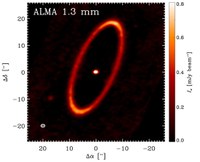
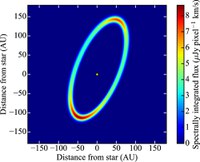
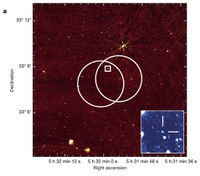
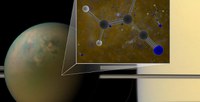
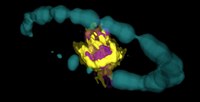
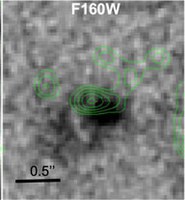
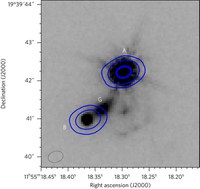






Connect with NRAO